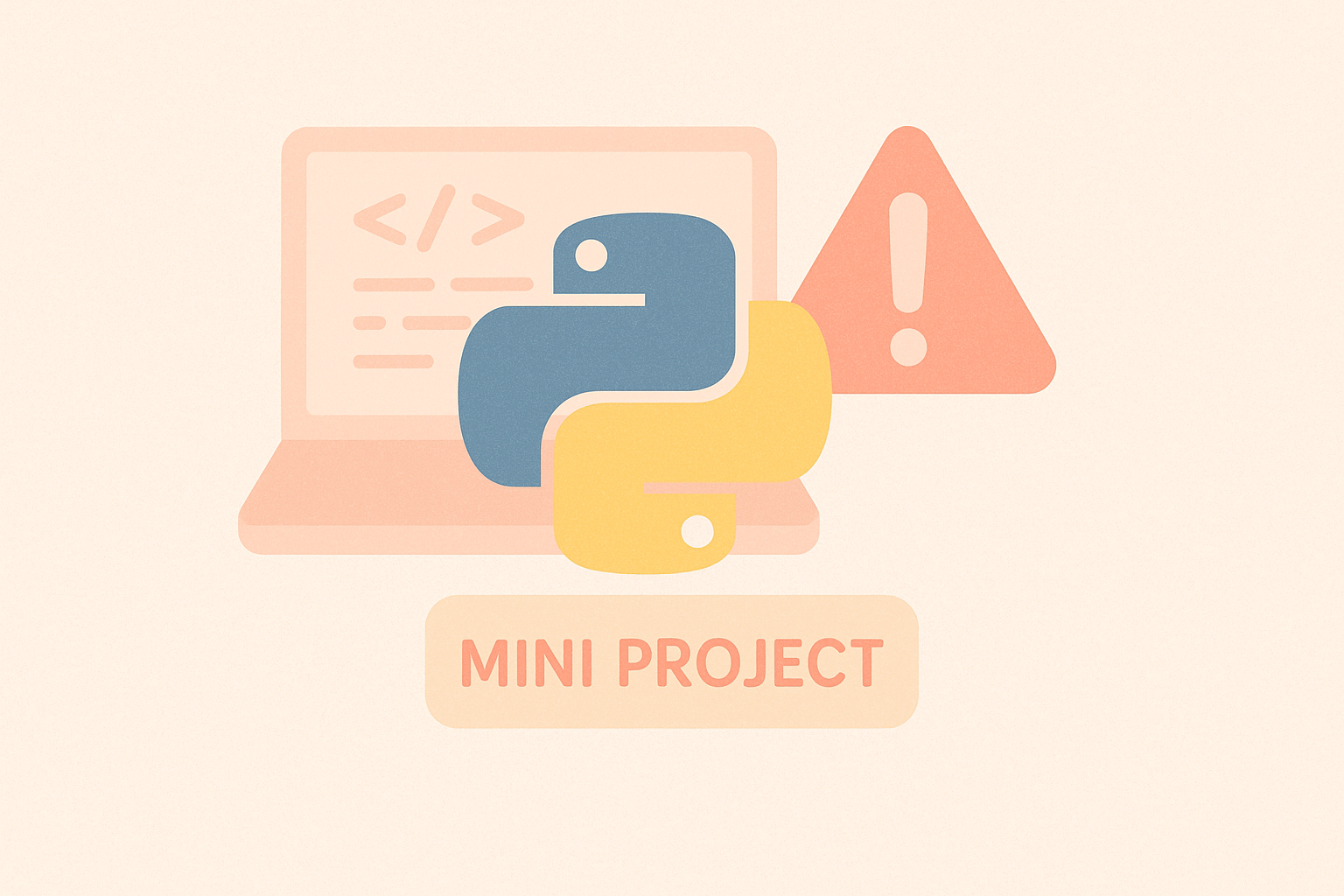Error handling is one of the most essential parts of programming. In Python, exceptions help you manage unexpected situations without crashing your entire program. In this mini project, we’ll explore how to build a simple yet practical exception handling system that improves code stability and user experience. This guide is designed for beginners who want to understand how to apply try-except blocks effectively in real-world scenarios.

What is Exception Handling in Python?
Exception handling allows your program to continue running even when an error occurs. Instead of stopping execution abruptly, Python lets you catch the error and handle it gracefully. This is done using the try, except, else, and finally blocks.
try:
# Code that may raise an exception
x = int(input("Enter a number: "))
result = 10 / x
except ZeroDivisionError:
print("Error: You cannot divide by zero.")
except ValueError:
print("Error: Please enter a valid number.")
else:
print("Success! The result is:", result)
finally:
print("Program finished.")
In the above example, Python safely handles both ZeroDivisionError and ValueError, ensuring that the program never crashes unexpectedly. The finally block always executes, making it ideal for cleanup tasks like closing files or database connections.
Mini Project: Simple Banking System with Exception Handling
Now let’s implement a small project to demonstrate how exception handling works in a more realistic example. We’ll create a mini banking application that allows users to deposit and withdraw money safely.
Project Requirements:
- Handle invalid input types (e.g., entering text instead of numbers)
- Prevent withdrawal of more money than the account balance
- Display custom error messages for different exceptions
Python Code Implementation:
class InsufficientBalanceError(Exception):
"""Custom exception for insufficient balance"""
pass
class BankAccount:
def __init__(self, owner, balance=0):
self.owner = owner
self.balance = balance
def deposit(self, amount):
try:
if amount <= 0:
raise ValueError("Deposit amount must be greater than zero.")
self.balance += amount
print(f"Deposited: ${amount}")
except ValueError as e:
print("Error:", e)
def withdraw(self, amount):
try:
if amount <= 0:
raise ValueError("Withdrawal amount must be greater than zero.")
if amount > self.balance:
raise InsufficientBalanceError("Not enough balance to complete this transaction.")
self.balance -= amount
print(f"Withdrew: ${amount}")
except ValueError as e:
print("Error:", e)
except InsufficientBalanceError as e:
print("Error:", e)
def check_balance(self):
print(f"Current balance: ${self.balance}")
# Example usage
if __name__ == "__main__":
account = BankAccount("Alice", 500)
try:
account.deposit(int(input("Enter deposit amount: ")))
account.withdraw(int(input("Enter withdrawal amount: ")))
except ValueError:
print("Please enter a valid number.")
finally:
account.check_balance()
print("Transaction completed.")
Explanation of the Code
In this project, we have created a BankAccount class that allows a user to deposit and withdraw money. Exception handling is used throughout to make the code robust:
- ValueError: Raised when the deposit or withdrawal amount is not a positive number.
- InsufficientBalanceError: A custom exception to prevent the user from withdrawing more than the available balance.
- finally block: Always executes to display the current balance and confirm transaction completion.
By using try-except blocks, our program ensures that any error is caught gracefully and informative messages are displayed to the user. This helps improve user trust and application reliability.
Why Exception Handling Matters
Without exception handling, a single unexpected error can stop your entire Python application. In production environments, this can lead to serious issues such as data loss or bad user experience. That’s why writing clean and safe code with try-except structures is crucial for both beginners and professionals.
Bonus Tips for Beginners
- Always use specific exceptions instead of a generic
except:block. - Use the
finallyblock to perform cleanup operations like closing files. - Create custom exceptions for your own project’s logic, just like
InsufficientBalanceError. - Keep exception messages clear and informative for better debugging.
Conclusion
This Python Exception Handling Mini Project demonstrates how to build a safe and user-friendly application by managing errors effectively. Exception handling is not just about fixing errors — it’s about designing software that can handle real-world situations gracefully.
With this knowledge, you can now apply similar techniques to your future projects, whether in finance, web applications, or data processing.
Start practicing exception handling today — it’s a small skill that makes a big difference in software reliability!

